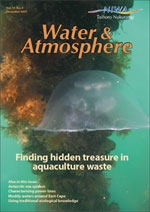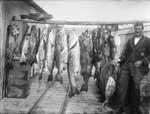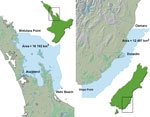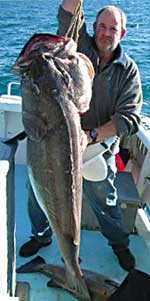PDF of this article (227 KB)





Kimberley Maxwell explains how the knowledge of local fishers and shellfish gatherers can be used to reconstruct our fisheries histories.
This research is part of a much larger multidisciplinary project investigating how humans and climate change may have impacted on the structure and functioning of the marine ecosystems of New Zealand’s continental shelf. Scientists are collating data in an effort to describe the marine ecosystem for five different eras:
- before human settlement – circa 1000
- during the early Māori phase – circa 1450
- before European exploitation – circa 1790
- before industrial-scale fishing – circa 1945
- modern day – 2007
The data we’re collecting include archaeological and historic information, stable isotope analysis of shellfish and otoliths (fish earbones) to determine climate conditions during their lives, climate data, commercial catch data, and traditional ecological knowledge (TEK) associated with fishing (hī ika) and shellfish gathering (kohikohi me te ruku kaimoana).
Traditional ecological knowledge
TEK is the knowledge of people with extensive experience and observations of an area or species, including knowledge passed down through oral tradition or shared among users of a resource. TEK has been recognised internationally as a way to improve scientific research and resource management by providing additional – and sometimes better – information. In this study, archaeological data will provide an idea of how humans impacted on the fish and shellfish resources up to about 1800, while historical data sources will be used to document marine resource use from the time of first European contact until the early 20th century. Modern fisheries records for many species were not well organised or established until the second half of the 20th century and have mainly focused on the commercial catch. Consequently, there’s a large gap in terms of what effect humans, especially customary and recreational fishers, had on fish and shellfish stocks from 1900 to the 1960s. TEK may be able to improve our knowledge of human impacts on the fisheries during this period.
Combining TEK with Western science is a relatively new technique in New Zealand fisheries research. Elsewhere, this approach has been used to demonstrate the decline of the Gulf grouper (Mycteroperca jordani) in the Gulf of California, Mexico. Here we’ll use similar social science research methods to collect and analyse the data so they can be incorporated into our marine ecosystem models. This includes conducting short interviews with local fishers and shellfish gatherers. We aim to interview an equal number of young (15–30 years old), middle-aged (31–54) and mature (55+) individuals. This will let us confidently compare our present-day data with that collected about the era before industrial fishing.
Our study sites and techniques
We’ve chosen two study areas for the project: the greater Hauraki Gulf (from Tutukākā to Waihī) in the North Island and the Otago/Catlins coast (from Ōamaru to Porpoise Bay) in the South Island. The study areas have many contrasting features that may reflect the effects of human impact and climate change on the marine ecosystems, including the surrounding human populations, land development, and ocean currents and temperatures. Also, both areas offer an extensive volume of earlier research, including oral histories, which we can incorporate into the bigger project. Many of the previous oral histories were collected for different research objectives and therefore are more likely to yield qualitative than quantitative information; this is why we must conduct further interviews.
Here’s an example of the type of data we’re gathering. I was fortunate enough to meet Pete Lamb, who has been fishing regularly in the Wellington region for 35 years. The largest hāpuku (Polyprion americanus) landed on his charter vessel was an estimated 67 kg and was caught in 200 m of water off Mana Island in 2005. In an article in Seafood New Zealand, I also found a picture of the hāpuku caught by Leslie and Wilfred McManaway who were regular fishers of the Wellington region 60 years ago. The caption said it weighed in at 120 kg and was caught in 360 m of water in the Cook Strait in 1947. The author of the article interviewed Wilfred’s son Basil McManaway, who was also a regular fisher in Wellington. During his best day’s catch, he remembers, they caught in excess of 250 hāpuku, and on an average day they would catch 70–80 large hāpuku on a set line. In contrast, on the day I went out in 2006 we caught a total of 24 hāpuku. Our catch was restricted by a catch limit of 2 hāpuku per fisher so, of course, it can’t be compared with Mr McManaway’s catch. However, taking into account advances in technology, we can plot this sort of information from an age-structured sample offishers to determine the trend over time in maximum weight and total number of fish caught.
How can TEK help?
We can use TEK to improve the data with which we manage our fisheries. Every year we estimate the catch a stock can safely sustain. The catch histories upon which these limits are in part based were started sometime after the beginning of full-scale commercial fishing, and are based on the best information available. In the case of hāpuku, the earliest landings data are from 1936, although widespread European and customary fisheries for this species occurred much earlier.
If history and trajectories of change are ignored, then an ecosystem is more likely to be perceived as being stable or pristine. This problem is termed ‘shifting baseline syndrome’, where the current status of an ecosystem is assumed to be ‘normal’, creating a bias in resource management decisions. Incorporating pre-industrial-scale fishing data into our fisheries models may increase how accurately we set our catch limits.
The estimates of historical stocks may also be used in the development of iwi environmental management strategies. In 2004, the Hauraki Māori Trust Board published the Hauraki Iwi Environmental Plan. Many of their key objectives for managing the Tangaroa Rerenga Wai Tai, or marine environment, include restoring species, habitats, and ecosystems. The results of this research may be used to indicate what previous species abundances and distributions, habitats and ecosystems were like. Kai Tahu has also published the Kai Tahu ki Otago Natural Resource Management Plan (2005). Overfishing and depletion of the Mahika Kai (kaimoana) or seafood resources are key issues they have identified. This research may be used to demonstrate the extent of this fishing and resource use.
Those were the days
- A large study of New Zealand’s marine ecosystems is characterising fish and shellfish stocks over the last millenium.
- Traditional ecological knowledge (TEK) draws on the observations and experiences of locals, and includes knowledge passed down through oral tradition or shared among users of a resource.
- TEK and Western science can be combined to fill gaps in the historical record of fish and shellfish stocks.
Further reading
Hauraki Māori Trust Board (2004). Whaia te mahere taiao a Hauraki: Hauraki Iwi Environmental Plan. Available as a pdf at www.hauraki.iwi.nz/publications/archive.htm
Kai Tahu ki Otago Ltd. (2005) Kai Tahu ki Otago Natural Resource Management Plan. Available at www.ktkoltd.co.nz/documents/
Morrison, M.; Taylor, R.; Walker, J.; Parsons, D. (2007). Marine recreation and coastal ecosystems. Water & Atmosphere 15(2): 18–19.
Sáenz-Arroyo, A.; Roberts, C.M.; Torre, J.; Cariño-Olvera, M.(2005). Using fishers’ anecdotes, naturalists’ observations and grey literature to reassess marine species at risk: the case of the Gulf grouper in the Gulf of California, Mexico. Fish and Fisheries 6: 121–133.
Stevens, P. (2007) Basil McManaway: salt of the ocean. Seafood New Zealand February 15(1): 47–49.
Kimberley Maxwell is based at NIWA in Wellington, and works on customary fisheries and benthic ecology. She acknowledges Dr Erica Williams, Dr Alison MacDiarmid, Taoho Patuawa (all at NIWA), and Pete Lamb, Peter Stevens, and Basil McManaway for their assistance in preparing this article. This project is supported by the Capability Fund and the Biodiversity Fund.
Teachers’ resource for NCEA Achievement Standards or Unit Standards: Biology Level 2 AS90769, US6309 Science Level 3 US21613
